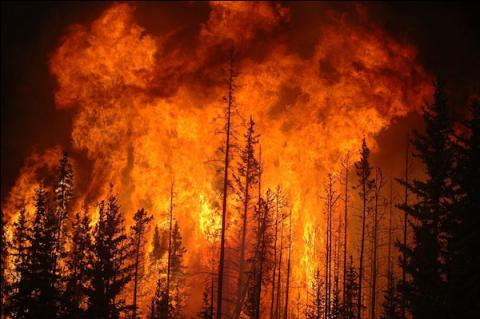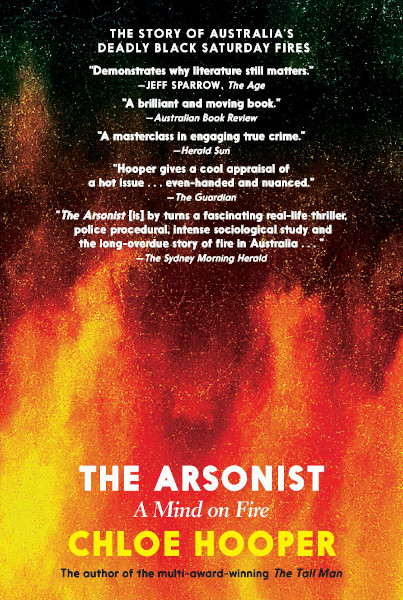Exploring the Crime of Fire in Chloe Hooper’s ‘The Arsonist’

The Arsonist: A Mind on Fire
By Chloe Hooper
Seven Stories Press
264 pages
Fire is one of those elements (like air and water) that has been described, explained and written about in countless ways. It’s a mark of the impressive powers Australian journalist Chloe Hooper brings to her new book, The Arsonist, that she makes a terrible conflagration come alive again before our eyes:
“Windows started to crack, then curtains were ablaze; skylights melted and began to drip; fire came under doors, or through the subfloor or the ceiling. The bins and buckets and plastic containers that people had filled with water seemed absurd. One man went outside to check if it was safe and came back with his boots on fire. Someone else ran from the flames and realized his jeans had ignited. People stayed alive by breathing through wet fabric, or lying in dams or creek beds. A man waited in a fishpond with a tea towel over his head.”
On February 7, 2009, wildfires swept across Victoria, a mainland state in Australia. In all, there were more than 400 individual fires, producing an inferno estimated as the catastrophic equivalent of 500 atomic bombs. In the end, the swath of devastation extended beyond 100 million acres. More than 3,500 buildings went up in smoke, and almost 200 people lost their lives. It’s impossible to estimate the extent of destruction where livestock and wildlife were concerned.
Henceforth, this date became known throughout the continent as Black Saturday.

The Arsonist, a true crime account of Black Saturday, is divided into three sections: “The Detectives,” “The Lawyers,” and “The Courtroom.” Within this structure, Hooper methodically details the efforts of the Victorian Arson Squad to investigate the horrific blaze -- in particular, one fire that broke out in a forestry plantation near the town of Churchill.
Investigators quickly determined the fire was deliberately set in this remote location in Australia’s coal country. Following up on physical evidence, as well as eyewitness testimony from others who’d suffered through the terrible day, the Arson Squad’s focus settled on one suspect early on—a highly unusual event in the annals of fire detection and apprehension.
Brendan Sokaluk, 39, had a troubled history of unemployment and brushes with the law, although he had once served as a voluntary firefighter. After his arrest and subsequent investigation, it also became clear he had serious mental deficiencies as well. He acknowledged being involved in the setting of the so-called Churchill blaze, although in his eyes, the crime of fire was “accidental.”
But throughout the three-year-long investigation and trial (which concluded in 2012 with his conviction on 10 counts of arson), Sokaluk remained a mystery to both prosecutors and his long-suffering defense attorneys:

“The legal contest had pitted the story of a fiend against that of a simpleton, but the two weren’t mutually exclusive. Brendan was both things: guileful and guileless, shrewd and naïve. A man apparently capable of unleashing chaos and horror, who now … looked so bewildered that when the lawyers said goodbye they felt devastated, for it seemed they were leaving behind a child.”
Part of the success of The Arsonist lies in the author’s determination to see both sides of this tragic tale. Early on, Hooper explores the arsonist’s troubled past, with enough sympathy for readers to grasp some of what went on in his mind the day of the fires, and for long afterwards.
At the same time, Hooper delves deeply into the harrowing effects of Black Saturday for residents of the area, as well the courageous men and women who tried to limit the range of destruction. People died trying to protect their homes, their families, and their possessions, and, to this day, the survivors remain haunted by their experience.
Blending eyewitness testimony, a close reading of thousands of pages of courtroom evidence, extensive interviews and other research, The Arsonist is an absorbing tale of one man’s tortured life and how the actions he took led to so much tragedy and horror throughout the community in which he lived.
Author Bio:
Lee Polevoi, Highbrow Magazine’s chief book critic, is the author of The Moon in Deep Winter, a novel.
For Highbrow Magazine
Image Sources:
--Seven Stories Press
--Cameron Strandberg (Wikimedia, Creative Commons)
Pemacallan (Pixabay, Creative Commons)






























































































































































































































































































































